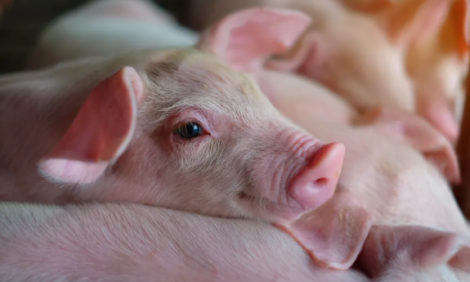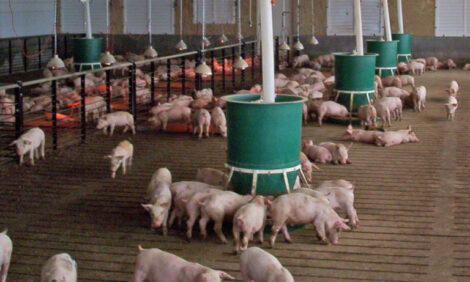



Influence of Dried Distillers’ Grains on Carcass Fat in Swine
Results of their trial led Mickey A. Latour and A. P. Schinckel of the Department of Animal Sciences at Purdue University to conclude that the optimum range for feeding dried distillers' grains (DDGS) is likely to be less than 20 per cent to avoid the pork belly becoming very soft.Introduction
One of the fastest moving by-products from the production of ethanol in the Midwest is dried distiller's grains with solubles (DDGS). As shown in other Purdue Extension BioEnergy publications, DDGS have high protein and fat content and can be included into a number of livestock and poultry diets. The fat component of DDGS is essentially concentrated corn oil and is known to affect carcass fat softness.
Dietary Intake and Pig Body Composition

Dietary intake plays a major role in determining
pig body composition, specifically
fat composition because pigs can directly
deposit dietary fat into their fat depots. This
transfer from diet to body fat is well characterised
in grow-finish pigs.
Saturated fatty acids tend to positively influence
fat quality by increasing firmness when
included in the diet. Conversely, unsaturated
fatty acids all tend to negatively affect fat by
causing it to have a softer composition. (See
Figure 1 for an example of a very firm pork
belly and a very soft belly.) Carcasses high
in unsaturated fat acids are characterized by
higher levels of oxidation, slicing and processing
difficulties.
One way to monitor fat firmness is by determining
the fatty acid profile and calculating
an iodine value (IV). Once the fatty acids
have been identified, the IV formula can be
applied as follows:
IV = (% C16:1 × 0.950) + (% C18:1 × 0.860) + (% C18:2 × 1.732) + (% C18:3 × 2.616) + (% C20:1 × 0.785) + (% C22:1 × 0.723)
Acceptable IV values vary depending on
the processor; however, an IV value over 70
frequently indicates soft fat and a less desirable
carcass. The Purdue University laboratory has recently published
that the relative abundance of saturated to unsaturated
fatty acids may be the best predictor
of soft fat tissue but regardless of method, the
processor wants non-soft fat tissue in pigs.
DDGS and Pig Fat
So, how does DDGS play a role in pig fat?
Again, the fat component of DDGS is concentrated
corn oil. So the abundance of C18:2n6
(commonly known as linoleic acid), the
primary fatty acid of corn, is very high and a
strong contributor to soft fat, as shown in the
IV calculation.
In the calculation, (C18:2 is multiplied by 1.732), so if
the other fatty acids remain somewhat constant and this
one increases by 1.5-fold, then the outcome of IV will go
up strongly. Normally, linoleic acid is around 12 per cent of all
the fatty acids in pigs (essentially 12×1.732 = 20.78 is the
contribution by linoleic acid alone), but when linoleic
acid content is increased by 1.5-fold in the carcass through
manipulations of diet, one can essentially add 11 IV to the
carcass (18 per cent linoleic acid × 1.732 = 31 points — the
20.78 IV points in normal carcass).
Conclusion
The authors' research and that done by others indicates that
adding DDGS at 10, 20, 30 or 40 per cent will increase carcass IV,
and they believe it is through the relative increase in the level
of linoleic acid being consumed. To illustrate the relative
change in 'soft belly' fat, click here, where animals were given no
DDGS and 10, 20, or 30 per cent DDGS.
The authors also believe from that study along with other work done,
that an optimum range for feeding DDGS will most likely
be less than 20 per cent inclusion, because that is the point where
bellies become noticeably very soft and and normally realise a
seven- to 10-point increase in IV. Alternatively, the animals will need
to be fed something that counteracts the effects of DDGS,
namely Conjugated Linoleic Acid (CLA). Adding one per cent CLA to pig diets can reduce five or six IV points from a pig carcass that had been consuming DDGS.
Thus, feeding DDGS, a common byproduct of ethanol
production, to pigs at concentrations of 20 per cent and above will
require addition of CLA to the diet in order to maintain
acceptable carcass fat firmness. Another important
component in feeding DDGS is that all pigs are not equal
in terms of fat composition independent of diet. That is, the
leaner the genetic population is, the greater the extent to
which the pigs' fatty acid profile will be more unsaturated,
meaning higher IV, so producers with super genetic lean
pigs may need to feed less DDGS compared to other
breeds. Additional research must be performed in this area.
October 2012








